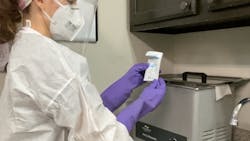Utility gloves: Why do we hate wearing them?
There is a lot of noncompliance surrounding the use of utility gloves in dentistry. Even though these gloves are great for cleaning and disinfecting, people find them difficult to use. This is a problem because the federal guidelines mandate that dental health-care professionals (DHCPs) wear them for safety and health.
In a dental practice, it's common to see several types of gloves:
- Exam gloves: single-use disposable gloves used for examining the patient’s mouth
- Surgical/sterile gloves: single-use gloves used in sterile environments for surgical procedures. The dentist or staff can wear nitrile gloves if they or the patient is allergic to latex.
- Overgloves: gloves worn over other gloves to allow DHCPs to touch surfaces or objects without contaminating the gloves underneath or other areas touched (cross-contamination)
- Utility gloves: reusable, heavy-duty, chemical- and puncture-resistant gloves for cleaning, sterilizing, and disinfecting treatment rooms and equipment. These are also helpful when moving, washing, or packing tools or other hazardous materials.
Most DHCPs do not mind using other types of gloves, but they are particularly unhappy with the utility gloves. Many confess to not wearing them even though they are expected to. To find out more, I surveyed DHCPs to understand why they hate utility gloves so much.
Survey findings on the use of utility gloves
When I asked about the use of utility gloves, this is what I found out.
DCHPs know utility gloves are part of the federal government’s measures to protect them. They are aware that the federal government has instituted various measures to keep them safe and that different agencies, such as the Centers for Disease Control and Prevention (CDC) and the Occupational Safety and Health Administration (OSHA), set the rules. These governing bodies recommend wearing utility gloves for nonmedical purposes, but health professionals may not consider using them in these situations.
Everyone needs to have their own specially fitted gloves. One barrier to using utility gloves is the failure to fit the user properly. They are bulky, and wearers struggle to handle tools or other instruments if the gloves are too big. Fumbling with any equipment could lead to injury in the workplace, not to mention the fact that it is annoying and can slow down DHCPs during tasks. Everyone should have their own pair of utility gloves that correctly fits their hand size. This will make it easier to handle instruments and remove a key challenge to wearing utility gloves.
There is a disconnect between people knowing utility gloves are mandatory and actually wearing them. Even though people know the federal requirements, many are willfully violating those rules. It makes little sense. The expectation is that everyone would respond positively to any attempts to make their jobs safer and healthier.
DHCPs say utility gloves are uncomfortable and make their work difficult. Many respondents explained the issues raised in the previous questions by saying the problem is the gloves themselves. They said the utility gloves are too bulky, do not fit properly, and take away the tactile sensitivity and precision crucial to their jobs. In addition, these gloves complicate some tasks because they prevent wearers from having the best grip on the tools they are using.
About half of the survey respondents wear utility gloves for room disinfection. While it is good to know that about half of those surveyed wear utility gloves when cleaning and disinfecting a room, that is still a very low number. As a result, many risky situations can arise while DCHPs clean hard-to-reach areas. Some potential hazards include injuries from needles and other sharp objects, as well as encountering dangerous chemicals.
Utility gloves can be sterilized many times. Utility gloves are autoclavable, meaning heat from the autoclave will kill pathogens. You can also clean the gloves by washing them inside out and drying them. Consistent washing and airing will help reduce or prevent odors.
Autoclaving or proper cleaning is done at least weekly. For those who autoclave their gloves, the survey indicates that they process them at least once a week. It is vital to take care of the inside of the gloves because some pathogens may be left behind after cleaning. Those pathogens can lead to cross- or recontamination of your hands. Consequently, it is important to perform proper hand hygiene, either by handwashing or using hand sanitizer, before and after donning and doffing all types of gloves.
Utility gloves make it challenging to reprocess rooms and instruments. Finally, many people felt that utility gloves made it difficult to reprocess rooms and tools. The main concerns were their bulkiness and awkwardness when disinfecting and sterilizing surfaces and equipment. People felt that the gloves hindered their tactile abilities.
We can find a plausible explanation for this disconnect in a survey I conducted last year on infection control. We discovered that many dental offices did not have adequate infection control programs or the time to apply the strategies efficiently. Moreover, dental hygienists said that some team members took longer to adapt to any changes the practice made.
The report showed that some professionals could either be afraid of change, uninformed, overwhelmed, or just complacent—all of which could lead to injury or ongoing exposure to chemicals when DHCPs choose to wear exam gloves instead of utility gloves for duties such as operatory turnover.
I taught myself to use utility gloves. It took time, and occasionally, I still find some tasks cumbersome, but I know we need to learn how to use them in the workplace. Once you figure it out, it becomes easier and faster to prepare instruments and treatment rooms for incoming patients.
The great thing about utility gloves is that they are reusable. This means you can save money on buying exam gloves for cleaning purposes. Also, with the ongoing pandemic, the supply chain management for gloves is tricky. Having utility gloves will keep your stock intact longer. As well, utility gloves provide better protection from punctures, grazes, and exposure to skin irritants than regular gloves.
This practical study on how to clean and store utility gloves showed concerns with the use of communal utility gloves that are never cleaned or sterilized. The small study showed that cleaning the gloves and storing them properly are essential and can decrease malodor and even contact dermatitis.
Even though all these points and concerns are valid, utility gloves are here to help us. We are a profession that has an incredible skill based on our tactile abilities. It is a bit strange to go from exploring for the tiniest bit of calculus to being unable to feel items that we pick up off our clinical trays. I believe we can train ourselves and learn to adapt to the tactile challenges presented by using utility gloves. Moreover, we can and should train our team members to ensure they also become comfortable using utility gloves.
A few takeaways
- Always go for high-quality utility gloves that are puncture- and chemical-resistant.
- Read manufacturers’ instructions to understand how to disinfect utility gloves correctly.
- Provide everyone with his/her own pair of utility gloves and make sure they fit properly.
Check the gloves periodically and remove torn, damaged, or worn-out ones. Be careful with nails and jewelry to avoid ruptures, and always wash your hands before and after wearing gloves.
If you follow these tips, you’ll be able to maintain a safe, comfortable environment for everyone. Remember, these thick puncture-resistant gloves are not meant to annoy us and make our jobs harder, even if it seems like it. They are meant to protect us from injury and chemical exposure, and I am here to tell you that you are worthy of that. We encounter so many occupational hazards throughout the day. Take the time to protect yourself, and ensure that you never have to stress over percutaneous injuries.
Editor's note: This article appeared in the September 2021 print edition of RDH.
Michelle Strange, MSDH, RDH, brings over 20 years of experience to her numerous roles in dentistry. A graduate of the Medical University of South Carolina with a bachelor’s of health science and the University of Bridgeport with a master’s in dental hygiene education, she is focused on expanding the knowledge of her colleagues in all aspects of health care. Strange’s passion for dentistry and its connection to overall health extends to her community and global efforts. Currently, she is the cofounder and cohost of the longest-running podcast for dental hygienists, A Tale of Two Hygienists, the cofounder of Level Up Infection Prevention and TriviaDent, a practicing dental hygienist, and client success manager for MouthWatch.
About the Author
Michelle Strange, RDH
Michelle Strange, RDH, is a dedicated dental hygienist and educator passionate about infection control and patient safety. With over 20 years of experience in clinical practice, Michelle is committed to sharing evidence-based solutions to improve dental care outcomes.

